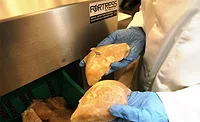Keep the Creatures from Stirring This Winter
Winter weather means heaters are cranked up to keep the cold at bay. And while you may shut out the frigid temperatures, it’s an open invitation for rodents seeking shelter from the cold. The abundance of food sources, numerous potential entry points, and hiding places in your facility can create a perfect storm for an infestation of rats or mice.
The unsightly presence of these rodents can lead to food contamination and, at the very least, threaten your food safety audit scores. A proactive approach to facility maintenance, including an effective integrated pest management program, can help keep rodents out and your food product and business secure. Here are a few tips to keep your facility unfriendly to rodents.
Keep trees trimmed and landscape plants at least 12 inches from your building to limit the chance that rodents will use vegetation to access the building. Consider installing a 2-foot wide gravel strip around the perimeter of the building. This can deter rodents from approaching the foundation since these pests prefer covered areas for travel and nesting.
Food and water sources often found in and around dumpsters attract rodents looking for a meal. Piled trash and boxes next to your building are an open invitation to rodents looking for refuge. Communicate regularly with your sanitation crew and waste management company to keep trash handling areas free from clutter and accumulated waste. Ask that your dumpsters are switched out regularly.
HVAC units are a common culprit for providing pests with water, so be sure that facility maintenance staff conducts regular inspections of these areas. Inspect locations where water often accumulates, including on top of, behind and underneath the units, as well as other hard-to-reach places.
Rats can squeeze through openings as small as a quarter, and mice can squeeze through holes the size of a dime, so any small openings are an entryway for rodents. Seal holes in exterior walls with water-resistant sealant and incorporate steel or copper mesh for extra protection. Keep in mind that rodents can enter your facility on pallets, shipments of ingredients, or through open doors. For this reason, loads must be inspected for pest evidence when received and doors should remain closed whenever possible. Consider roll-up screen doors for locations where ventilation is needed. Also, install double-doors for frequently used entryways to make it harder for rodents to enter.
Remind your employees to keep food stored in the break room refrigerator in re-sealable plastic containers and to clean out lockers regularly. Keep break room or kitchen areas clean—even a few crumbs can attract rodents. Clean drains and equipment with an organic cleaner to eliminate the residue that pests can feed on. Monitor for spills and leaks, and clean and repair them immediately—pests only need a small amount of food and moisture to survive.
Educated employees can be one of your facility’s best defenses against rodents. Work with your pest management company to ensure that all employees are trained on pest prevention. Early detection and identification of pest problems and conditions that attract pests can help keep issues to a minimum. Encourage employees to report any pest concerns and provide a central spot to document pest sightings. A problem left unaddressed can (and usually does) turn into a much bigger issue.
One of the top lines of defense against rodents is continuous vigilance. Train your employees to look for the following pest signs and make sure to contact your pest management professional immediately if these are reported:
• Droppings – Visible rodent droppings in and around your facility are a strong indicator that you have a problem. Look for mouse droppings, which are pointed and about the size of a grain of rice, and rat droppings, about the size of a raisin.
• Gnaw marks – Rodents will gnaw on wires, sealant, wood and other hard materials. Since rodents can enlarge an opening such as a conduit or pipe penetration by gnawing around the edges, closely inspect any areas in the building that appear to be chewed or gnawed.
• Rub markings – Look for any greasy markings on walls, wires or pipes inside your facility that may indicate a rodent is regularly traveling along these paths.
Winter pests, particularly rodents, are hazardous and bothersome, but infestations can be prevented. By being proactive and working with your pest management professional, plant managers can breathe a little easier.
Patrick Copps is technical services manager for Orkin’s Pacific Division. A board-certified entomologist in urban and industrial entomology, he has more than 35 years of experience in the industry. For more information, contact him at pcopps@rollins.com or visit www.orkincommercial.com.
Looking for quick answers on food safety topics?
Try Ask FSM, our new smart AI search tool.
Ask FSM →








